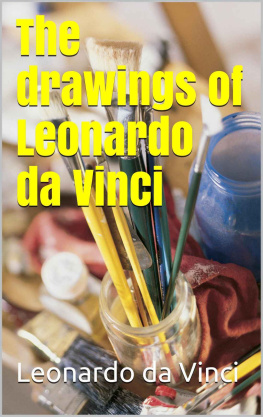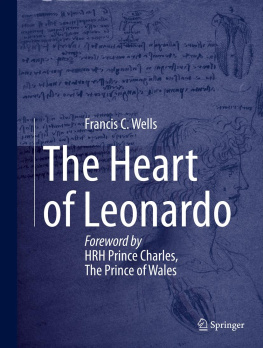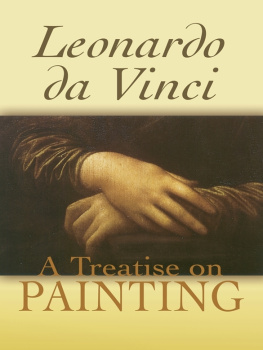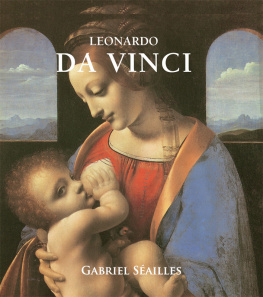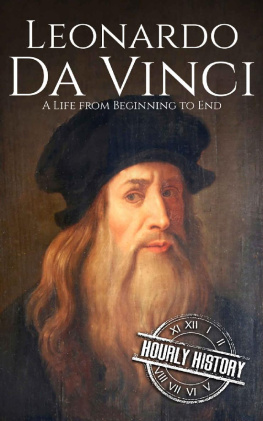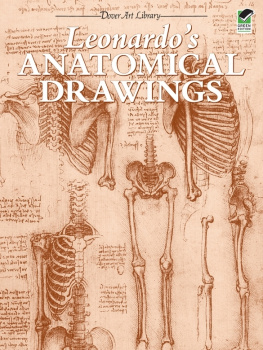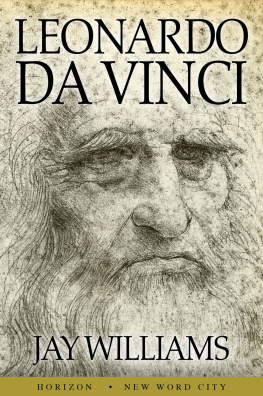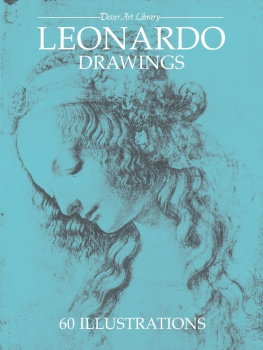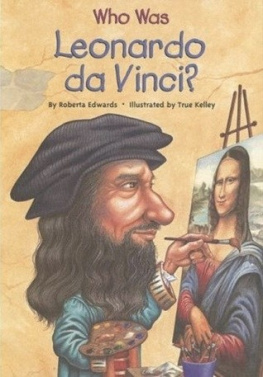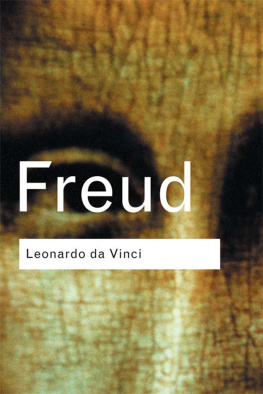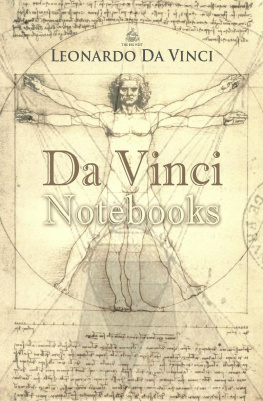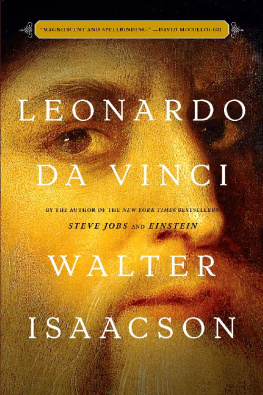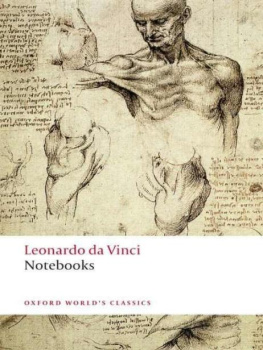da Vinci Leonardo - The Drawings of Leonardo Da Vinci Master Draughtsman Series
Here you can read online da Vinci Leonardo - The Drawings of Leonardo Da Vinci Master Draughtsman Series full text of the book (entire story) in english for free. Download pdf and epub, get meaning, cover and reviews about this ebook. year: 2015, genre: Detective and thriller. Description of the work, (preface) as well as reviews are available. Best literature library LitArk.com created for fans of good reading and offers a wide selection of genres:
Romance novel
Science fiction
Adventure
Detective
Science
History
Home and family
Prose
Art
Politics
Computer
Non-fiction
Religion
Business
Children
Humor
Choose a favorite category and find really read worthwhile books. Enjoy immersion in the world of imagination, feel the emotions of the characters or learn something new for yourself, make an fascinating discovery.
- Book:The Drawings of Leonardo Da Vinci Master Draughtsman Series
- Author:
- Genre:
- Year:2015
- Rating:3 / 5
- Favourites:Add to favourites
- Your mark:
- 60
- 1
- 2
- 3
- 4
- 5
The Drawings of Leonardo Da Vinci Master Draughtsman Series: summary, description and annotation
We offer to read an annotation, description, summary or preface (depends on what the author of the book "The Drawings of Leonardo Da Vinci Master Draughtsman Series" wrote himself). If you haven't found the necessary information about the book — write in the comments, we will try to find it.
da Vinci Leonardo: author's other books
Who wrote The Drawings of Leonardo Da Vinci Master Draughtsman Series? Find out the surname, the name of the author of the book and a list of all author's works by series.
The Drawings of Leonardo Da Vinci Master Draughtsman Series — read online for free the complete book (whole text) full work
Below is the text of the book, divided by pages. System saving the place of the last page read, allows you to conveniently read the book "The Drawings of Leonardo Da Vinci Master Draughtsman Series" online for free, without having to search again every time where you left off. Put a bookmark, and you can go to the page where you finished reading at any time.
Font size:
Interval:
Bookmark:
This book made available by the Internet Archive.
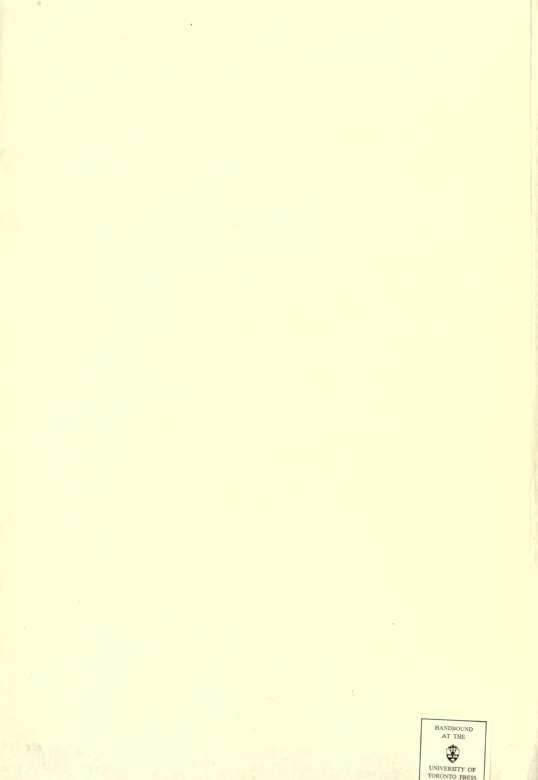
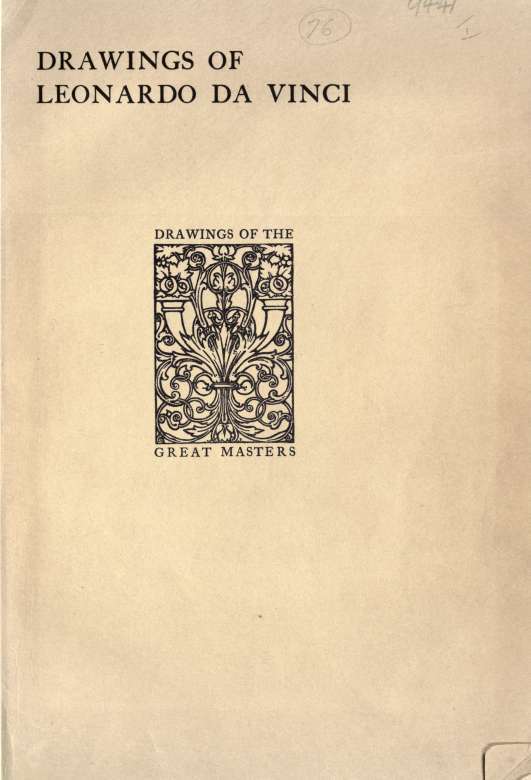
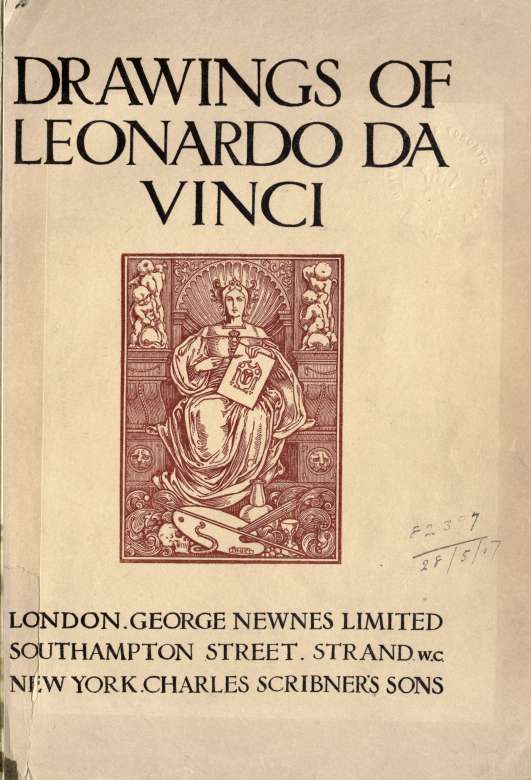
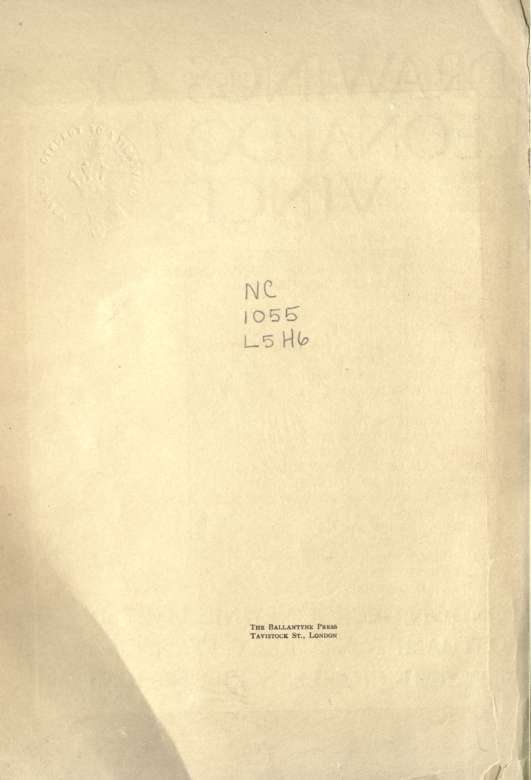
PLATE
PROFILE OF A WARRIOR... Frontispiece
PORTRAIT OF ISABELLA D'ESTE i
STUDY OF AN OLD MAN n
STUDY OF DRAPERIES FOR KNEELING FIGURES . in
STUDY OF A BACCHUS iv
HEAD OF A MAN v
BATTLE BETWEEN HORSEMEN AND MONSTERS . vi WOMAN SEATED ON GROUND AND CHILD
KNEELING vn
STUDIES OF HEADS vm
YOUTH ON HORSEBACK ix
STUDIES FOR THE EQUESTRIAN STATUE OF
FRANCESCO SFORZA x
}^THE VIRGIN, ST. ANNE AND INFANT ... xi
STUDIES OF CHILDREN , xii
THE COMBAT xm
STUDY FOR A MADONNA xiv
STUDIES FOR "THE HOLY FAMILY" ... xv
STUDIES FOR "THE LAST SUPPER" .... xvi
COURTYARD OF A CANNON-FOUNDRY... xvn
STUDY OF THE HEAD OF AN APOSTLE... xvm STUDY FOR BACKGROUND OF "THE ADORATION
OF THE MAGI" xix
STUDY OF LANDSCAPE xx
STUDY OF A TREE xxi
TWO HEADS. CARICATURES xxn
ST. JOHN THE BAPTIST xxm
THE HEAD OF CHRIST xxiv
CARICATURES xxv
HEAD OF AN ANGEL xxvi
STUDY OF A MAN'S HEAD xxvn
PLATE
STUDIES OF HANDS ..... xxvm
DRAGON FIGHTING WITH A LION .... xxix
MAN KNEELING xxx
PORTRAIT STUDY xxxi
STUDIES OF ANIMALS xxxn
PORTRAIT OF LEONARDO, BY HIMSELF... xxxni
SIX HEADS OF MEN AND A BUST OF A WOMAN xxxiv
STUDY OF A HEAD xxxv
THE ST. ANNE CARTOON xxxvi
STUDIES OF HORSES xxxvn
HEADS OF A WOMAN AND A CHILD... xxxvm
STUDY OF DRAPERY FOR A KNEELING FIGURE . xxxix
KNIGHT IN ARMOUR XL
STUDY OF A YOUTHFUL HEAD XLI
STUDY FOR "LEDA" XLII
HEAD OF AN OLD MAN XLIII
STUDY OF A HEAD XLIV
STUDY OF THE HEAD OF ST. PHILIP FOR "THE
LAST SUPPER" XLV
STUDY OF DRAPERY XLVI
GIRL'S HEAD XLVII
STUDIES OF A SATYR WITH A LION XLVIII
THE DRAWINGS OF LEONARDO DA VINCI
BY C. LEWIS HIND

EONARDO DA VINCI found in drawing the readiest and most stimulating way of self-expression. The use of pen and crayon came to him as naturally as the monologue to an eager and egoistic talker. The outline designs in his " Treatise on Painting" aid and amplify the text with a force that is almost unknown in modern illustrated books. Open the pages at random. Here is a sketch showing " the greatest twist which a man can make in turning to look at himself behind.'* The accompanying text is hardly needed. The drawing supplies all that Leonardo wished to convey.
Unlike Velasquez, whose authentic drawings are almost negligible, pen, pencil, silver-point, or chalk were rarely absent from Leonardo's hand, and although, in face of the Monna Lisa and The Virgin of the '^pcks and the St. Anne^ it is an exaggeration to say that he would have been quite as highly esteemed had none of his work except the drawings been preserved, it is in the drawings that we realise the extent of " that continent called Leonardo." The inward-smiling women of the pictures, that have given Leonardo as painter a place apart in the painting hierarchy, appear again and again in the drawings. And in the domain of sculpture, where Leonardo also triumphed, although nothing modelled by his hand now remains, we read in Vasari of certain " heads of women smiling."
" His spirit was never at rest," says Antonio Billi, his earliest biographer, " his mind was ever devising new things." The restlessness of that profound and soaring mind is nowhere so evident as in the drawings and in the sketches that illustrate the manuscripts. Nature, in lavishing so many gifts upon him, perhaps withheld concentration, although it might be argued that, like the bee, he did not leave a flower until all the honey or nourishment he needed was withdrawn. He begins a drawing on a sheet of paper, his imagination darts and leaps, and the paper is soon covered with various
THE DRAWINGS OF LEONARDO DA VINCI designs. Upon the margins of his manuscripts he jotted down pictorial ideas. Between the clauses of the " Codex Atlanticus " we find an early sketch for his lost picture of Leda.
The world at large to-day reverences him as a painter, but to Leonardo painting was but a section of the full circle of life. Everything that offered food to the vision or to the brain of man appealed to him. In the letter that he wrote to the Duke of Milan in 1482, offering his services, he sets forth, in detail, his qualifications in engineering and military science, in constructing buildings, in conducting water from one place to another, beginning with the clause, " I can construct bridges which are very light and strong and very portable." Not until the end of this long letter does he mention the fine arts, contenting himself with the brief statement, " I can further execute sculpture in marble, bronze, or clay, also in painting I can do as much as any one else, whoever he be." Astronomy, optics, physiology, geology, botany, he brought his mind to bear upon all. Indeed, he who undertakes to write upon Leonardo is dazed by the range of his activities. He was military engineer to Caesar Borgia ; he occupied himself with the construction of hydraulic works in Lombardy ; he proposed to raise the Baptistery of San Giovanni at Florence ; he schemed to connect the Loire by an immense canal with the Saone ; he experimented with flying-machines ; and his early biographers testify to his skill as a musician. Painting and modelling he regarded but as a moiety of his genius. He spared no labour over a creation that absorbed him. Matteo Bandello, a member of the convent of Santa Maria della Grazie, gives the following account of his method when engaged upon The Last Supper. " He was wont, as I myself have often seen, to mount the scaffolding early in the morning and work until the approach of night, and in the interest of painting he forgot both meat and drink. There came two, three, or even four days when he did not stir a hand, but spent an hour or two in contemplating his work, examining and criticising the figures. I have seen him, too, at noon, when the sun stood in the sign of Leo, leave the Corte Vecchia (in the centre of the town), where he was engaged on his equestrian statue, and go straight to Santa Maria della Grazie, mount the scaffolding, seize a brush, add two or three touches to a single figure, and return forthwith."
Leonardo impressed his contemporaries and touched their imaginations, even as he captivates us to-day. Benvenuto Cellini describes King Francis as hanging upon Leonardo's words during the last years of his life, and saying that " he did not believe that any other o
THE DRAWINGS OF LEONARDO DA VINCI
man had come into the world who had attained so great a knowledge as Leonardo." Everybody knows Pater's luminously imaginative essay on Leonardo, and scientific criticism has said perhaps the last word upon his achievement in Mr. McCurdy's recent volume, and in Mr. Herbert P. Home's edition of Vasari's " Life." As to the drawings, Mr. Bernhard Berenson, in his costly work on " The Drawings of the Florentine Masters," has included a catalogue raisonne, has scattered lovely reproductions through the pages, and placed his favourites on the pinnacle of his appreciation. In the manuscripts, with their wealth of sketches in the text, one realises the tremendous sweep of Leonardo's mental activity. Some are still unpublished, but the Italian Government promise a complete edition of the MSS. at an early date. His " Treatise on Painting " is easily accessible in Dr. Richter's " Literary Works of Leonardo da Vinci" that wonderful treatise which begins : " The young student should, in the first place, acquire a knowledge of perspective, to enable him to give every object its proper dimensions : after which, it is requisite that he be under the care of an able master, to accustom him, by degrees, to a good style of drawing the parts. Next, he should study Nature, in order to confirm and fix in his mind the reason of those precepts which he has learnt. He must also bestow some time in viewing the works of various old masters, to form his eye and judgment, in order that he may be able to put in practice all that he has been taught." Chapter ccxxx. in the section on " Colours " is entitled " How to paint a Picture that will Last Almost for Ever." In view of the present condition of The Last Supper at Milan, fading from sight, Leonardo was wise to insert the word " almost." He is constantly giving the reader surprises, and not the least of them is the series of" Fables" from his pen, included in Dr. Richter's edition of his literary works.
Next pageFont size:
Interval:
Bookmark:
Similar books «The Drawings of Leonardo Da Vinci Master Draughtsman Series»
Look at similar books to The Drawings of Leonardo Da Vinci Master Draughtsman Series. We have selected literature similar in name and meaning in the hope of providing readers with more options to find new, interesting, not yet read works.
Discussion, reviews of the book The Drawings of Leonardo Da Vinci Master Draughtsman Series and just readers' own opinions. Leave your comments, write what you think about the work, its meaning or the main characters. Specify what exactly you liked and what you didn't like, and why you think so.

